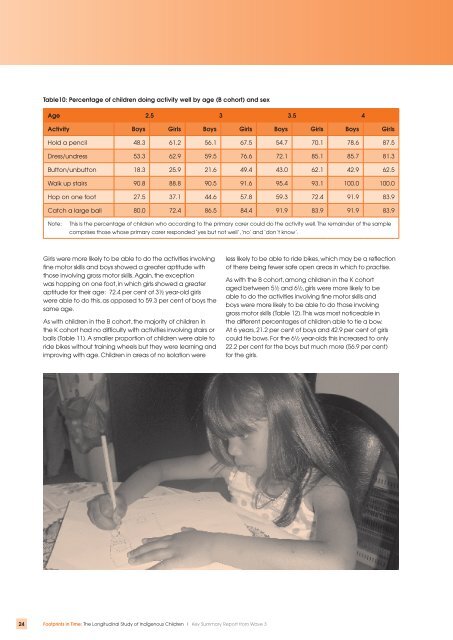Summary Report - pdf - Department of Families, Housing ...
Summary Report - pdf - Department of Families, Housing ...
Summary Report - pdf - Department of Families, Housing ...
Create successful ePaper yourself
Turn your PDF publications into a flip-book with our unique Google optimized e-Paper software.
Table10: Percentage <strong>of</strong> children doing activity well by age (B cohort) and sexAge 2.5 3 3.5 4Activity Boys Girls Boys Girls Boys Girls Boys GirlsHold a pencil 48.3 61.2 56.1 67.5 54.7 70.1 78.6 87.5Dress/undress 53.3 62.9 59.5 76.6 72.1 85.1 85.7 81.3Button/unbutton 18.3 25.9 21.6 49.4 43.0 62.1 42.9 62.5Walk up stairs 90.8 88.8 90.5 91.6 95.4 93.1 100.0 100.0Hop on one foot 27.5 37.1 44.6 57.8 59.3 72.4 91.9 83.9Catch a large ball 80.0 72.4 86.5 84.4 91.9 83.9 91.9 83.9Note:This is the percentage <strong>of</strong> children who according to the primary carer could do the activity well. The remainder <strong>of</strong> the samplecomprises those whose primary carer responded ‘yes but not well’, ‘no’ and ‘don’t know’.Girls were more likely to be able to do the activities involvingfine motor skills and boys showed a greater aptitude withthose involving gross motor skills. Again, the exceptionwas hopping on one foot, in which girls showed a greateraptitude for their age: 72.4 per cent <strong>of</strong> 3½ year-old girlswere able to do this, as opposed to 59.3 per cent <strong>of</strong> boys thesame age.As with children in the B cohort, the majority <strong>of</strong> children inthe K cohort had no difficulty with activities involving stairs orballs (Table 11). A smaller proportion <strong>of</strong> children were able toride bikes without training wheels but they were learning andimproving with age. Children in areas <strong>of</strong> no isolation wereless likely to be able to ride bikes, which may be a reflection<strong>of</strong> there being fewer safe open areas in which to practise.As with the B cohort, among children in the K cohortaged between 5½ and 6½, girls were more likely to beable to do the activities involving fine motor skills andboys were more likely to be able to do those involvinggross motor skills (Table 12). This was most noticeable inthe different percentages <strong>of</strong> children able to tie a bow.At 6 years, 21.2 per cent <strong>of</strong> boys and 42.9 per cent <strong>of</strong> girlscould tie bows. For the 6½ year-olds this increased to only22.2 per cent for the boys but much more (56.9 per cent)for the girls.24 Footprints in Time: The Longitudinal Study <strong>of</strong> Indigenous Children | Key <strong>Summary</strong> <strong>Report</strong> from Wave 3




![pdf [107kB] - Department of Families, Housing, Community Services](https://img.yumpu.com/51272499/1/190x245/pdf-107kb-department-of-families-housing-community-services.jpg?quality=85)










![Land Claim - pdf [278kB] - Department of Families, Housing ...](https://img.yumpu.com/47002639/1/184x260/land-claim-pdf-278kb-department-of-families-housing-.jpg?quality=85)

![Borroloola Land Claim - pdf [299kB] - Department of Families ...](https://img.yumpu.com/46103973/1/184x260/borroloola-land-claim-pdf-299kb-department-of-families-.jpg?quality=85)